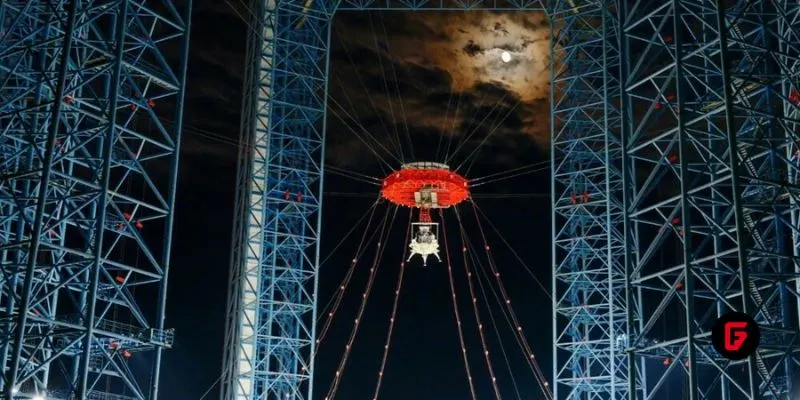By futureTEKnow | Editorial Team
If you thought drones were already getting small, think again. China’s National University of Defense Technology (NUDT) has just introduced a bionic drone so tiny, it could be mistaken for an insect. This mosquito-sized marvel is poised to shake up the world of military surveillance, and it’s a glimpse into the future of micro-robotics and covert tech.
If you thought drones were already getting small, think again. China’s National University of Defense Technology (NUDT) has just introduced a bionic drone so tiny, it could be mistaken for an insect. This mosquito-sized marvel is poised to shake up the world of military surveillance, and it’s a glimpse into the future of micro-robotics and covert tech.
At just 1.3 centimeters long, this drone isn’t just small—it’s engineered to mimic the flight of a mosquito. Its leaf-shaped wings, ultra-light body, and hair-thin legs aren’t just for show. They allow the drone to move like an insect, making it incredibly hard to spot with the naked eye or even with radar.
But the real magic is inside. The drone is packed with ultra-miniaturized cameras and microphones, giving it the ability to capture images, record audio, and even intercept electronic signals. It’s controlled via smartphone, making it flexible for field operations and special missions.
Military surveillance has always been about staying one step ahead, and this drone is a leap. Here’s why:
Stealth: Its size and insect-like movement make it almost invisible, perfect for sneaking into places where traditional drones can’t go.
Versatility: From tracking individuals to eavesdropping on conversations, its potential uses go far beyond the battlefield.
Engineering Feat: Building something this small and capable required breakthroughs in materials science, bionics, and micro-device engineering.
China isn’t alone in this race. Countries like the U.S. and Norway are also developing palm-sized and micro UAVs for military use. The Norwegian Black Hornet, for example, has already seen action with Western forces. What sets China’s mosquito drone apart is its extreme miniaturization and bionic design, reflecting a broader push for “intelligent warfare” and next-gen robotics.
While the tech is impressive, it raises some big questions. Experts warn that drones this small could be used for surveillance in sensitive locations, including government facilities. Their tiny size means limited battery life and payload, but for short, targeted missions, that might not matter.
As these drones become more capable, the line between science fiction and reality continues to blur. The potential for privacy invasion, espionage, and even sabotage is real—and it’s something policymakers and technologists will need to grapple with as the technology matures.
The debut of China’s mosquito-sized bionic drone is more than just a technical milestone. It’s a signal that the future of surveillance—and perhaps warfare itself—is getting smaller, smarter, and harder to detect. As these technologies evolve, staying informed and vigilant will be more important than ever for both industry insiders and the public.
What do you think about the rise of micro-drones? Could they change the balance of power in military tech, or are they just another tool in the arsenal? If you enjoyed this breakdown, follow for more updates on emerging tech and the future of surveillance.
Founded in 2018, futureTEKnow is a global database dedicated to capturing the world’s most innovative companies utilizing emerging technologies across five key sectors: Artificial Intelligence (AI), immersive technologies (MR, AR, VR), blockchain, robotics, and the space industry. Initially launched as a social media platform to share technology news, futureTEKnow quickly evolved into a comprehensive resource hub, spotlighting the latest advancements and groundbreaking startups shaping the future of tech.

Bridgit Mendler’s Northwood Space is pioneering mass-produced ground stations, enabling scalable, high-speed connectivity for the new era of satellite networks and megaconstellations.

SpaceX aims to nearly double launches from Vandenberg in 2025, facing support from federal agencies but strong objections from the state and local communities.

Traditional Medicare will pilot AI-assisted prior authorization in 2026 across six states, focusing on high-risk outpatient services. Clinicians retain final say, but incentives and access concerns loom as CMS tests fraud reduction and “gold card” exemptions. Here’s what providers and patients should know.

OpenArt’s new “one-click story” compresses scripting, visuals, and edits into ready-to-post short videos—fueling viral growth and a fresh IP debate. We break down how it works, adoption signals, what’s next (multi-character, mobile), and practical guardrails creators and brands should follow to stay original and compliant.

OpenAI’s o3 swept the Kaggle AI chess tournament, defeating xAI’s Grok 4–0. The victory fueled the intense rivalry between Altman and Musk, reshaping AI benchmarks.

NASA and Google’s AI-powered Crew Medical Officer Digital Assistant enables autonomous diagnoses for astronauts on Mars missions, redefining remote healthcare for space and Earth.

Pinterest’s CEO confirms that fully agentic AI shopping is years away, as the platform invests in AI-powered tools to enhance discovery, inspiration, and personalized shopping experiences for millions.

Shopify’s new AI shopping tools are transforming e-commerce, letting agents and chatbots deliver smooth, personalized shopping and checkout experiences across platforms. Learn how these innovations reshape online retail.

Meta has acquired WaveForms AI, a startup pioneering emotion-detecting voice technology. Learn what this means for Meta’s AI voice ambitions and the future of AI audio.

Tracelight is revolutionizing financial modelling for finance professionals with AI-powered Excel tools that automate complex tasks, reduce errors, and unlock new analysis capabilities. Learn how this next-gen solution changes the future of spreadsheets.

China’s Lanyue lander completed its first major test, showcasing advanced engineering for safe, crewed moon landings before 2030. Explore how this milestone shapes the space race.

Microsoft rolls out GPT-5 across its Copilot suite, integrating smarter AI for enterprise and personal users. Discover new features, free access, and what sets this launch apart.
To provide the best experiences, we use technologies like cookies to store and/or access device information. Consenting to these technologies will allow us to process data such as browsing behavior or unique IDs on this site. Thanks for visiting futureTEKnow.